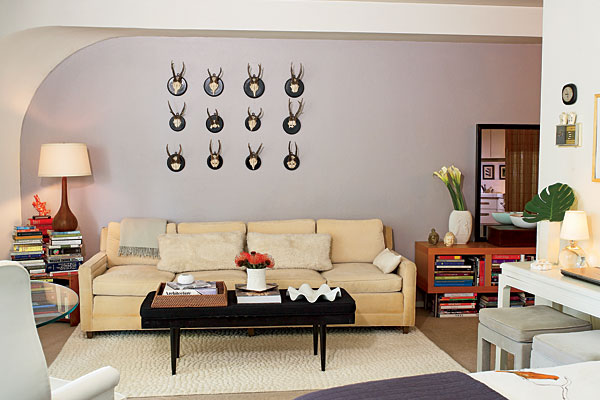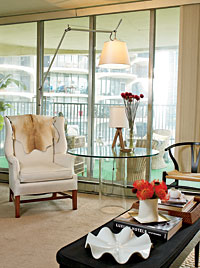
Lockemann prefers neutral furnishings with punches of color provided by accessories, plants, and a lavender-gray wall. The antler collection belonged to her dad, who displayed it high on the walls of a tiny bathroom.
SIZE 500 square feet
TYPE Studio
LOCATION River North
Though Stephanie Lockemann is a designer, she wasn’t necessarily looking for a design challenge back in 2002, when she decided it was time to leave the spacious Roscoe Village home she’d been sharing with roommates. She simply wanted to move closer to her job downtown. “I was sick of the commute,” she explains. “I’m not a morning person at all.”
Lockemann ended up renting a studio apartment in a building that would delight any designphile—one of the “corncob” towers of the world-renowned Marina City, designed by Bertrand Goldberg in 1959. The dimensions of the space were not so delightful, however: a 500-square-foot pie-shaped wedge, where none of the interior walls are at right angles to one another. She was up to the challenge, though. An inveterate thrift-store shopper, she gradually replaced the single plastic table and futon she had brought to the apartment with a mix of secondhand treasures and a few new pieces, creating a home that is both warm and sophisticated.

Lockemann has a knack for combining found pieces with new ones, such as a chic floor lamp from Room & Board with a wing chair she found in a thrift store and reupholstered. A frequent entertainer, she has extra seating available throughout the apartment, including a coffee table that’s also a bench.
Lockemann credits her sense of style to the “impeccable eye” of her dad. “I always thought it was so great that he had a priceless Biedermeier cabinet next to a couch my brother found on his way home from a pub,” she says. She was nearly as lucky, finding the sofa that anchors her main seating area for just $40 at The Ark, a North Side thrift shop. Not only was it a neutral color—her preference for furniture—but it also dates to the same era as the building, which was completed in 1964. She threw the cream-colored velvet cushion covers in the wash, said a prayer, and breathed a sigh of relief when they emerged clean and intact.
A beat-up, crewel-embellished wingback chair from The Ark got more of a makeover. Lockemann had always wanted a piece of white furniture and had it reupholstered in Sunbrella, an outdoor grade of fabric she calls “indestructible.” The ability to withstand red-wine spills is important, as she throws a lot of parties, including an annual birthday bash honoring architect Goldberg.
“I don’t believe things should be precious; they should be utilitarian,” Lockemann says. But that doesn’t mean she isn’t willing to splurge on the right piece, such as the Hans Wegner Wishbone chair tucked into a corner of the seating area. “I like how opposite it is to the upholstered piece—it’s dainty, almost sculptural.”
Her other significant investment was a Tolomeo articulated floor lamp, which Locke- mann bought with the $500 Room & Board gift certificate she won in a design contest on ApartmentTherapy.com, a home-design Web site. Lockemann has quite a collection of lamps, in fact, ranging from a simple teak table number to an industrial-looking Tizio Micro table lamp. Each is outfitted with a low-wattage bulb so she can light them all at once without creating the effect of a warehouse store.
Across from the seating area is the bed, a landing pad where she eats, reads, and watches TV. The height of the bed necessitated a tall headboard, which she constructed herself from two-by-fours and plywood wrapped in batting, then covered with a nubby oatmeal-colored fabric. She sketched out what she envisioned next to the bed, a slim table that could function as both a nightstand and a computer desk. Serendipitously she found exactly what she had in mind at a junk store—a console that needed only a coat of white paint to work perfectly in the space.
One of the biggest draws of the 29th-floor apartment is the west-facing balcony, and Lockemann eagerly anticipates outdoor lounging season each year. “It’s this whole other room,” she says. “And what’s brilliant is that you still have enough privacy out there. I love to have coffee outside in the morning, have friends over.” Last summer she used the balcony for a small wedding reception.
She has outfitted the space with thrift-store finds and iron chairs passed down from a friend. The balcony shines in the evening, when she lights candles in her collection of lanterns. “I love sparkle—from glass, metal, mirrors,” she explains. “It just livens things up.”
Right before Lockemann found her apartment, a psychic predicted that she would find a place on the water and told her “You’re going to be really happy there.” In this case, the prediction was accurate; she has come to love her little home so dearly that she is hoping to buy a place in the building—a bigger piece of pie—and stay for good.
RESOURCES
Living room: Area rug, Crate & Barrel, crateandbarrel.com. Bookcases, Ikea, ikea.com. Tolomeo floor lamp, Room & Board, roomandboard.com. Bedroom: Artemide Tizio task light, Lightology, 215 W. Chicago Ave., 312-944-1000. Duvet cover and pillowcases, Chinoiserie by Dwell Studio, dwellshop.com. Balcony: Custom pillows, Trina Turk indoor/outdoor fabric in Super Paradise Print, Schumacher, fschumacher.com.
Photography: Andreas Larsson
Related:


